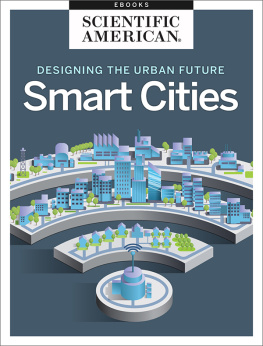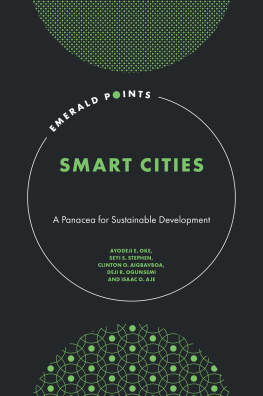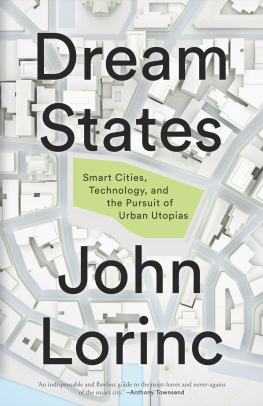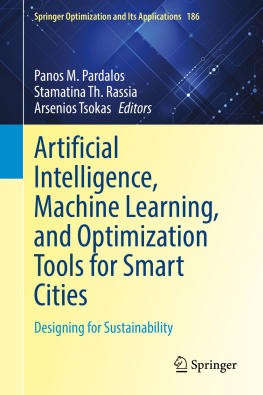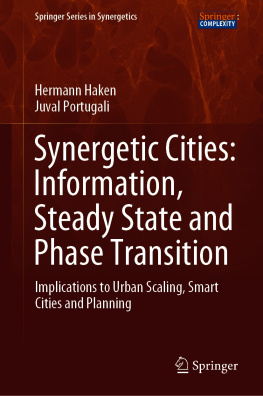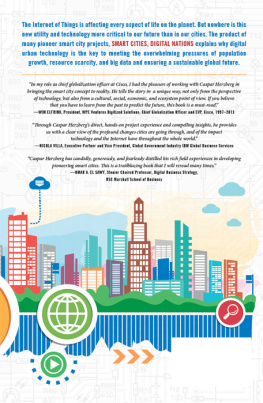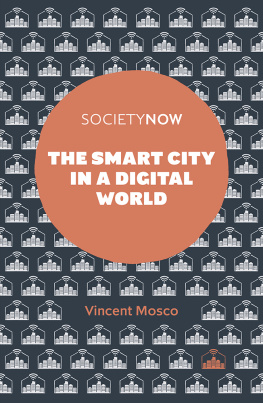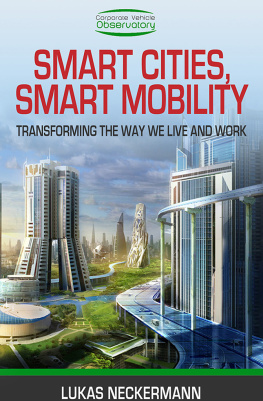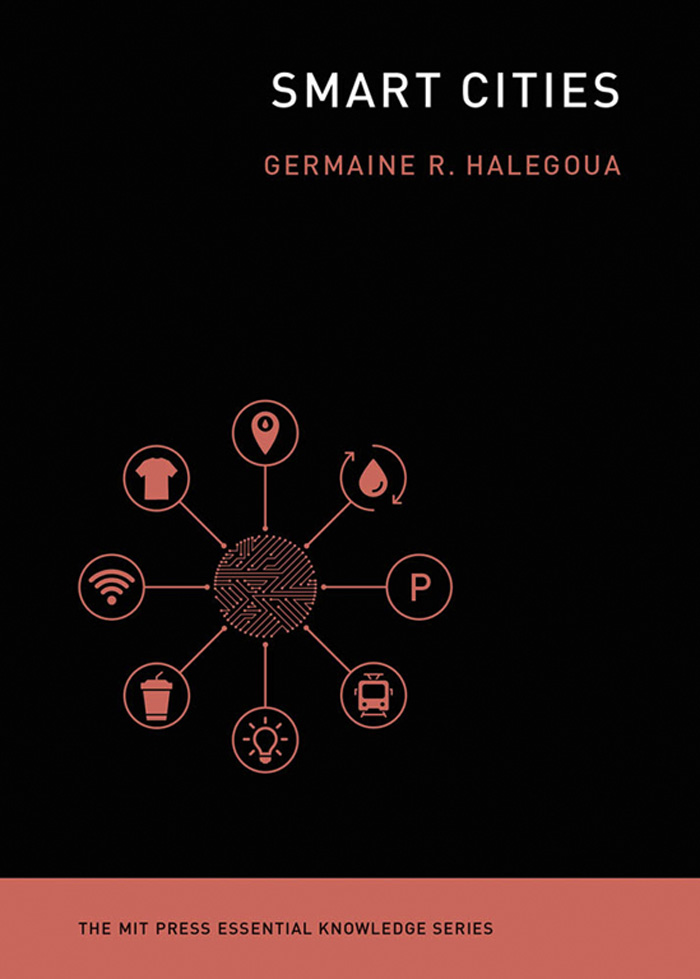
Smart CitiesP
The MIT Press Essential Knowledge Series
A complete list of the titles in this series appears at the back of the book.
Smart Cities
Germaine R. Halegoua
The MIT Press | Cambridge, Massachusetts | London, England
2020 Massachusetts Institute of Technology
All rights reserved. No part of this book may be reproduced in any form by any electronic or mechanical means (including photocopying, recording, or information storage and retrieval) without permission in writing from the publisher.
This book was set in Chaparral Pro by Toppan Best-set Premedia Limited.
Library of Congress Cataloging-in-Publication Data
Names: Halegoua, Germaine R., 1979- author.
Title: Smart cities / Germaine R. Halegoua.
Description: Cambridge, MA : MIT Press, [2020] | Series: MIT Press essential knowledge series | Includes bibliographical references and index.
Identifiers: LCCN 2019015278 | ISBN 9780262538053 (pbk. : alk. paper)
Subjects: LCSH: Smart cities. | Cities and townsEffect of technological innovations on.
Classification: LCC TD159.4 .H35 2020 | DDC 307.760285dc23
LC record available at https://lccn.loc.gov/2019015278
10 9 8 7 6 5 4 3 2 1
Contents
Series Foreword
The MIT Press Essential Knowledge series offers accessible, concise, beautifully produced pocket-size books on topics of current interest. Written by leading thinkers, the books in this series deliver expert overviews of subjects that range from the cultural and the historical to the scientific and the technical.
In todays era of instant information gratification, we have ready access to opinions, rationalizations, and superficial descriptions. Much harder to come by is the foundational knowledge that informs a principled understanding of the world. Essential Knowledge books fill that need. Synthesizing specialized subject matter for nonspecialists and engaging critical topics through fundamentals, each of these compact volumes offers readers a point of access to complex ideas.
Bruce Tidor
Professor of Biological Engineering and Computer Science
Massachusetts Institute of Technology
Introduction
Journalists as well as municipal officials have been eager to declare certain cities to be the first, largest, or most innovative smart city in the world. For example, on January 1, 2017, the technology news website Digital Trends listed Singapore, Barcelona, Oslo, and New York City as four cities that have integrated the most cutting-edge smart technologies and never-before-tested city planning initiatives into urban space and urban life. Among these innovations were ubiquitous sensors, cameras, and Wi-Fi networks used to monitor and report traffic flows, energy and water consumption, and crime in domestic and public spaces, along with the automation of mundane aspects of everyday lifefrom the programmed illumination of streetlights to sensors that count toilet flushes. Uniting these cities under the category of smart are goals of improving urban problems through digital technology solutions. By accumulating and processing digital information about certain urban activities, mobilities, and infrastructures, smart city developers hope to make cities more responsive, efficient, sustainable, and safe.
Urban environments promoted as smart cities have become both crucibles and showrooms for the practical application of the Internet of things (IoT), cloud computing, and the integration of big data processing into everyday life. Over the past 10 years, technology companies, governments, and urban developers all over the world have promoted smart cities as attainable future places where urban life is made knowable and manageable through data collection and analysis. These urban spaces are imagined as utilizing enhanced digital infrastructure, real-time data, and ubiquitous computing to foster efficiency in city management and governance and to improve quality of life for urban residents. Cities that are not yet smart are recognized as inefficient spaces; they may utilize technology to function but might be using outdated infrastructure and network models or collecting data about some, but not all, urban activities.
Government agencies, technology companies, and independent foundations have offered competitive funding opportunities with names like Smart Cities Challenge and Smart Gigabit Communities Program to encourage smart city construction. Public-private partnerships between municipal or national governments and corporations such as Cisco, IBM, Intel, Microsoft, and Siemens have produced plans to retrofit existing cities with sensors, digital kiosks, public Wi-Fi, and Internet-ready cameras, and to build new smart cities from the ground up. Although smart cities are being discussed and constructed worldwide, there is limited consensus about the concept, purpose, and consequences surrounding smart city development.
Are smart cities disruptive, or even innovative, urban developments? As more cities that claim to be smart are built or retrofitted across the globe, debates on this question have proliferated. Proponents of smart city development emphasize the role of technology in smart growth, improved public services, efficient infrastructures, and entrepreneurial competitiveness. However, critics voice suspicion about the datafication of urban processes, surveillance of urban populations, and the eagerness of public officials to regard information and communication technologies (ICTs) as solutions for perceived urban problems. Still other researchers and planners see great potential in smart city enterprises that broaden ideas about data collection and use, include input from urban residents, and foster collaboration with communities and neighborhoods.
The corporate- or technology-driven iterations of the smart city are only a subset of many possible ways that urban informatics can take hold, but they currently remain the dominant model for smart city development. Several critics note the ways in which these visions of the connected or networked city are highly problematic. For example, the city is not merely a series of technological solutions that process or optimize urban life; it is an actually existing place where lived experiences and preexisting community behaviors should be understood and integrated into urban infrastructures. Emergent smart city planning and goals have begun to shift conversations and innovations away from the indiscriminate implementation of sensors and IoT for efficiency and optimization, toward socially and culturally informed understandings of urban issues and inequities, an expanded roster of smart city stakeholders and policymakers, and the use of big data for public benefit. Questions linger about whom the smart city is for, how to measure its success, and who participates in its creation and use; they should continue to be asked of the companies and government entities that support these projects and the agencies that fund smart city development.
As the concerns and potential promises of smart cities multiply, it is imperative that citizens and scholars understand the processes and issues at hand. Many discussions and policy decisions about smart cities occur within boardrooms or conferences geared toward technology industry representatives, government officials, and urban developers. In order for members of the public to contribute to the development of urban space, they will need to understand the urban transformations being proposed, how their cities and towns are being reshaped by digital media implementation and use, and where and how they can intervene in these processes.
Next page

